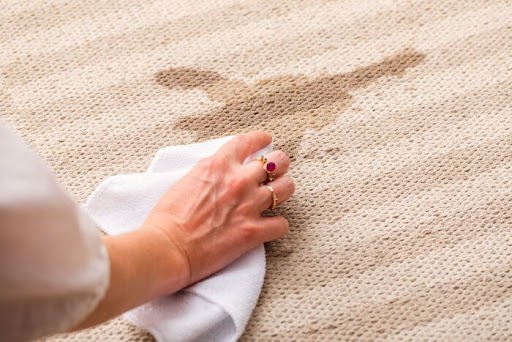As much as you might try to prevent stains from getting in your carpets, they’re not always easy to avoid. Accidents happen, whether a drink gets spilled, a new pet misses the litter tray or you cut yourself and blood spots end up splattered on the carpet.
Although it’s disheartening to see a carpet become stained, especially if it’s new or it’s only just been professionally cleaned, the situation might not be as dire as you first think. Many types of stains can be successfully removed from a carpet, as long as you use the right cleaning solutions and methods for your particular carpet fabric and the type of stain.
In many cases, you won’t even need to rush out to the nearest shop for a stain removal product, as you can often remove carpet stains using store cupboard items you might already have at home, such as baking soda or white vinegar.
1. Blot the excess spillage
First thing’s first – as soon as a spillage or dirt ends up on a carpet, give it your full attention right away. The sooner you act to remove a stain, the less likely it will become a permanent problem.
Your first task should be to remove as much of the excess liquid from the carpet as possible, if it came from a spillage, for example, a drink or from pet urine. A kitchen towel is ideal for this task.
If you’re dealing with a solid rather than a liquid, such as mud, pet faeces, food or vomit, use an old spoon or blunt knife to scoop up as much of the soiling as possible.
2. Dampen the spillage
Once you’ve attempted to remove as much excess fluid or solids as possible from the carpet, the next step is to add a very small amount of water to the stain. Then, blot at the spillage with a clean kitchen towel or microfibre cloth. Blotting and dabbing at the stain will help to transfer the spillage onto the towel or cloth, but it’s really important to avoid scrubbing the stain, as this could cause it to set deeper into the carpet.
3. Apply a cleaning solution
To remove the stain from your carpet, applying a combination of one part white vinegar and equal amounts of water may be all that you need. You can either apply this to the stain directly, mixing the two ingredients in a bowl, or adding the solution to a spray bottle and spritzing it onto the carpet.
After you’ve left this mixture to work into the stain, you can then blot the stain again and leave the carpet to dry.
Hopefully, this should be enough to remove the stain, but if some of the stain remains, you could also try adding some baking soda to it. Leave it overnight, and then vacuum it up the next day.
4. Removing specific types of stains from a carpet
This is a general method that can work for a wide range of stains, but you might need to adapt your technique depending on the particular type of stain you’re dealing with. Here are some of the most common kinds of stains that can end up in a carpet, and how to deal with them.
5. Red wine
A red wine stain on a new cream carpet – it’s everyone’s worst nightmare! But, it might not be as horrendous as you think. As with other spillages and stains, the key thing is to act fast when a glass of vino gets splashed on the carpet.
There are different methods that you can use to attempt to remove a red wine stain, and in some cases the above technique might suffice. If the water and vinegar cleaning solution isn’t strong enough, you could try adding a bit of non-bleach soap to the mix.
Some people also swear by using salt. After you’ve blotted the red wine spillage, sprinkle some salt over the stained area, leaving it for several minutes. Then, add some water to the spillage and blot the area. You may need to repeat this process a few times until all of the red wine has been fully removed. Don’t forget to vacuum the area once the carpet is dry to pick up the loose salt crystals.
6. Coffee
Red wine isn’t the only troublemaker that can stain a carpet – coffee is also notorious for ending up spilled on a carpet. You can use the same method for removing coffee stains as for red wine spillages. Vinegar and baking soda are both said to be effective at removing the tannins contained in coffee.
Alternatively, some people swear by mixing a quarter of a cup of lemon juice with two cups of warm water, and applying this mixture to the coffee spillage, before blotting it.
Remember to never over-wet the carpet when you’re trying to remove the coffee stain – or any stain for that matter – as the moisture could seep into the carpet underlay and cause mould and mildew to form.
7. Pet stains
When you get a new pet, it’s inevitable that your carpets might bear the brunt of one or two toileting accidents until your pet settles in and becomes fully toilet trained. However, it’s really important that you remove any pet stains thoroughly, because any traces left behind may encourage them to mark the same spot again. It’s, therefore, vital to not only remove the stain itself, but to neutralise the odour of the stain.
The vinegar and water solution might be enough to remove pet stains from your carpet, but if any odours or traces of the stain remain, you can try adding some baking soda to the stain. Alternatively, mix two cups of water with half a cup of hydrogen peroxide and add to a spray bottle to squirt onto the area, before blotting.
You might also be able to buy special stain removers that are geared towards removing pet urine and other pet stains from carpets.
8. Blood
If you cut yourself and blood ends up on a carpet, naturally you’ll want to attend to your injury first. But, don’t forget about sorting out your carpet! The longer you leave the blood in the carpet, the sooner it will turn into a permanent stain.
Fresh blood can be lifted from a carpet by spraying a mix of water and soap detergent in a bottle, followed by blotting the area and then rinsing with cold water. You might need to repeat this process a few times until the blood stain has disappeared.
If the blood has dried, use a soft brush on the stain before you apply the above solution, to help break the deposits up.
For stubborn blood stains, you could try mixing half a cup of warm water with a tablespoon of ammonia and blotting onto the stain, before sponging with cold water, and then blotting again.
9. Trust the professionals
Although stains can be removed from your carpets using DIY techniques, there are always risks involved. You might find that you can’t fully remove the stain from the carpet, or, worse still, you could end up making the stain set further into fabrics, so it becomes permanent. Additionally, using the wrong cleaning solution or technique might damage carpet fibres and even if you remove the stain, you could be left with a discoloured patch on your carpet. Sticky cleaning residues left in a carpet could even encourage more dirt to build up in fabrics.
You might save a few pennies by attempting to remove a stain from a carpet yourself, but it’s not worth the risk if a carpet ends up damaged.
To ensure that stains can be fully removed effectively and safely, without the risk of harm to your carpets, it’s worth using the services of a professional stain removal cleaning company, like Carpet Bright UK.
We have vast experience in all areas of stain removal, including how to get rid of a wide range of stains from different types of carpet fabrics. We use effective cleaning solutions that remove all traces of the stain and any remaining residues or associated lingering odours.
When you get stains removed from your carpets, it’s also worth considering protecting your carpets from future stains. We can provide stain protection for your carpets, which involves applying an odourless and invisible product to carpets that repels spillages, helping to prevent them from turning into stubborn stains.
Contact Carpet Bright UK for more information on our dependable and affordable stain removal and stain protection services.







